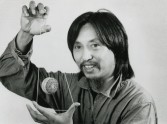
Perfumed Nightmare
Who Invented the Yo-Yo? Who Invented the Moon Buggy?
Screening on Film
$12 Special Event Tickets
With his first film, the former Eric de Guia not only debuted his nom du cinéma, Kidlat Tahimik (meaning “quiet lightning” in Tagalog), but also its onscreen incarnation, a character that would become as inseparable from the filmmaker himself as Chaplin’s Little Tramp. And like the Tramp, Tahimik presents himself as a naïf, the better to draw audiences into his autobiographical journey of de-colonization. Seamlessly blending fiction, autobiography, history and ethnography, the film begins as a self-portrait of Tahimik, his family and friends, and his hometown. When Kidlat realizes a lifelong dream to visit Europe, the disillusioning experience causes him to revisit his idealization of Western culture and technology. This political awakening is told with both gentle humor and burning fervor. As a result, The Perfumed Nightmare has become not only a founding text of “third cinema” and a classic of the surrealist counter-ethnographic genre; it’s also justly recognized as one of the finest essay films ever made.
In this rarely seen sequel to The Perfumed Nightmare, Tahimik’s fascination with interplanetary travel has led him to start a Filipino space program in the fictional German town where he lives. His colleagues are toddlers, and together they build a rocket out of scrap metal. This engagingly childlike premise enables Tahimik to present imagination and play as a parodic critique of the hegemonic use of technology. In both its style and its content, this film demonstrates Tahimik’s belief in a DIY ethos as an aesthetic and a political alternative to the pretensions of mastery exemplified by modern science and commercial cinema alike.










